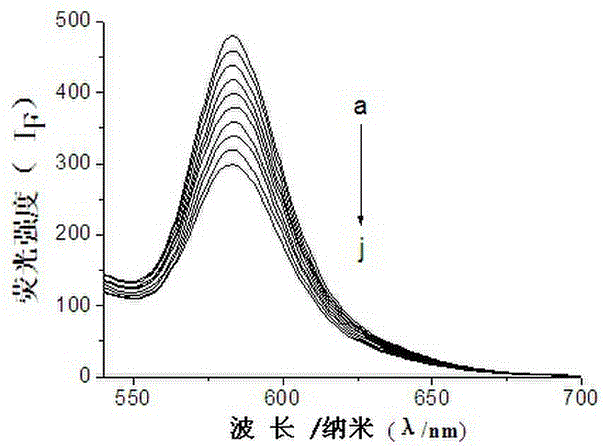Method for detecting gibberellin in food using cyclodextrin and fluorescence resonance energy transfer technology
A fluorescence resonance energy, technical detection technology, applied in the direction of fluorescence/phosphorescence, material excitation analysis, etc., to achieve accurate, convenient and fast detection, and improve sensitivity and selectivity.
- Summary
- Abstract
- Description
- Claims
- Application Information
AI Technical Summary
Problems solved by technology
Method used
Image
Examples
Embodiment Construction
[0015] 1. Detection method:
[0016] Add 100 microliters of 1.0×10 to each of ten 10ml colorimetric tubes -5 mol / L riboflavin solution, 120 microliters 1.0×10 -4 mol / liter of butylrhodamine B solution, 1 ml of 1.0×10 -3 mol / L of β-cyclodextrin solution and 20 microliters of 0.1 g / L polyvinyl alcohol solution, and then add 40, 120, 200, 280, 360, 440, 520 , 600, 680, and 760 ng / mL gibberellin solutions, respectively, with disodium hydrogen phosphate (0.2 mol / L)-citric acid (0.1 mol / L) buffer solution of pH=6.6 to adjust the volume to the mark, and react 3 Minutes later, the fluorescence intensity was detected with a RF-5301PC fluorescence photometer, the excitation wavelength was 360 nm, and the excitation and emission slit widths were both 5 nm.
[0017] 2. Drawing of working curve:
[0018] Add 100 microliters of 1.0×10 to each of ten 10ml colorimetric tubes -5 mol / L riboflavin solution, 120 microliters 1.0×10 -4 mol / liter of butylrhodamine B solution, 1 ml of 1.0×10 -...
PUM
| Property | Measurement | Unit |
|---|---|---|
| wavelength | aaaaa | aaaaa |
Abstract
Description
Claims
Application Information
 Login to View More
Login to View More - R&D
- Intellectual Property
- Life Sciences
- Materials
- Tech Scout
- Unparalleled Data Quality
- Higher Quality Content
- 60% Fewer Hallucinations
Browse by: Latest US Patents, China's latest patents, Technical Efficacy Thesaurus, Application Domain, Technology Topic, Popular Technical Reports.
© 2025 PatSnap. All rights reserved.Legal|Privacy policy|Modern Slavery Act Transparency Statement|Sitemap|About US| Contact US: help@patsnap.com


